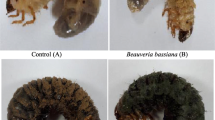Abstract
Third- and fifth-instar larvae ofMalacosoma disstria are highly susceptible to infection by the microsporidian speciesNosema disstriae, Pleistophora schubergi, andVairimorpha necatrix. More than 80% mortality occurred when third-instar larvae received 5×104 spores. The relative susceptibility ofM. disstria to the three parasites is indicated by the number of spores needed to kill 50% of the treated fifth-instar larvae:V. necatrix, 1.4×103;P. schubergi, 2.3×104; andN. disstriae, 2.3×105 spores/larva. Days to death forN. disstriae andP. schubergi generally decreased with increasing spore numbers; however, larger doses ofV. necatrix caused much earlier death.
Similar content being viewed by others
References
Chu WH, Jaques RP (1981) Factors affecting infectivity ofVairimorpha necatrix (Microsporidia: Nosematidae) toTrichoplusia ni (Lepidoptera: Noctuidae). Can Ent 113:93–102
Cole RJ (1970) The application of the “Triangulation” method to the purification ofNosema spores from insect tissues. J Invertebr Pathol 15:193–195
Fuxa JR (1981) Susceptibility of lepidopterous pests to two types of mortality caused by the microsporidiumVairimorpha necatrix. J Econ Entomol 74:99–102
Fuxa JR, Brooks WM (1979) Mass production and storage ofVairimorpha necatrix (Protozoa: Microsporida). J Invertebr Pathol 33:86–94
Grisdale D (1973) Large volume preparation and processing of a synthetic diet for insect rearing. Can Ent 105:1553–1557
Hamm JJ, Lynch RE (1982) Comparative susceptibility of the granulate cutworm, fall armyworm, and corn earworm to some entomopathogens. J Georgia Ent Soc 17:363–369
Henry JE, Oma EA, Onsager JA (1979) Infection of corn earworm,Heliothis zea, withNosema acridophagus andNosema cuneatum from grasshoppers: relative virulence and production of spores. J Invertebr Pathol 34:125–132
Kaya HK (1973) Pathogenicity ofPleistophora schubergi to larvae of the orange-striped oakworm and other lepidopterous insects. J Invertebr Pathol 22:356–358
Maddox JV, Brooks WM, Fuxa JR (1981)Vairimorpha necatrix a pathogen of agricultural pests: potential for pest control. In: Burges HD (ed) Microbial control of pests and plant diseases 1970–1980. Academic Press, London, pp 586–594
Nordin GL, Maddox JV (1972) Effects of simultaneous virus and microporidian infections on larvae ofHyphantria cunea. J Invertebr Pathol 20:66–69
Wilson GG (1977) Effects of the microsporidiaNosema disstriae andPleistophora schubergi on the survival of the forest tent caterpillar,Malacosoma disstria (Lepidoptera: Lasiocampidae). Can Ent 109:1021–1022
Wilson GG (1982) Protozoans for insect control. In: Kurstak E (ed) Microbial and viral pesticides. Marcel Dekker, New York, pp 587–600
Author information
Authors and Affiliations
Rights and permissions
About this article
Cite this article
Wilson, G.G. Pathogenicity ofNosema disstriae, Pleistophora schubergi andVairimorpha necatrix (Microsporidia) to larvae of the forest tent caterpillar,Malacosoma disstria . Z. Parasitenkd. 70, 763–767 (1984). https://doi.org/10.1007/BF00927129
Accepted:
Issue Date:
DOI: https://doi.org/10.1007/BF00927129



